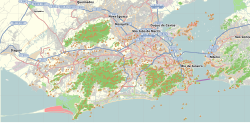Pão de Açúcar
| Sugarloaf Mountain | |
|---|---|
 |
|
| Highest point | |
| Elevation | 396 m (1,299 ft) |
| Coordinates | 22°56′55″S 43°09′26″W / 22.94861°S 43.15722°WCoordinates: 22°56′55″S 43°09′26″W / 22.94861°S 43.15722°W |
| Geography | |
| Location | Rio de Janeiro, Brazil |
Sugarloaf Mountain (Portuguese: Pão de Açúcar pronounced: [ˈpɐ̃w̃ d͡ʒi aˈsukaʁ]) is a peak situated in Rio de Janeiro, Brazil, at the mouth of Guanabara Bay on a peninsula that juts out into the Atlantic Ocean. Rising 396 m (1,299 ft) above the harbor, its name is said to refer to its resemblance to the traditional shape of concentrated refined loaf sugar. It is known worldwide for its cableway and panoramic views of the city.
The mountain is one of several monolithic granite and quartz mountains that rise straight from the water's edge around Rio de Janeiro.
The mountain is protected by the Sugarloaf Mountain and Urca Hill Natural Monument, created in 2006. This became part of a World Heritage Site declared by UNESCO in 2012.
The name "Sugarloaf" was coined in the 16th century by the Portuguese during the heyday of sugar cane trade in Brazil. According to historian Vieira Fazenda, blocks of sugar were placed in conical molds made of clay to be transported on ships. The shape given by these molds was similar to the peak, hence the name.
A glass-walled cable car (bondinho or, more formally, teleférico), capable of holding 65 people, runs along a 1,400 m (4,600 ft) route between the peaks of Sugarloaf and Morro da Urca every 20 minutes. The original cable car line was built in 1912 and rebuilt around 1972–73 and in 2008. The cable car goes from a ground station, at the base of Morro da Babilônia, to Morro da Urca and thence to Sugarloaf's summit.
...
Wikipedia

